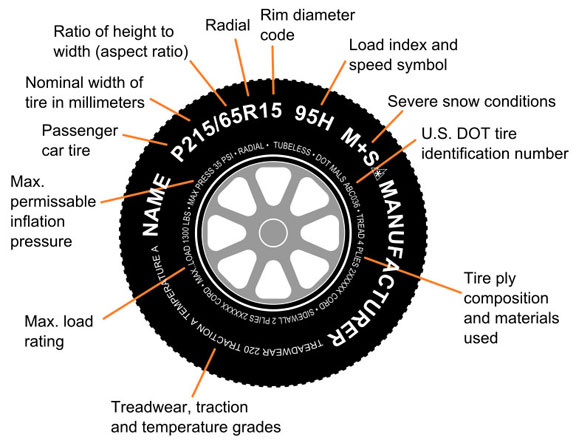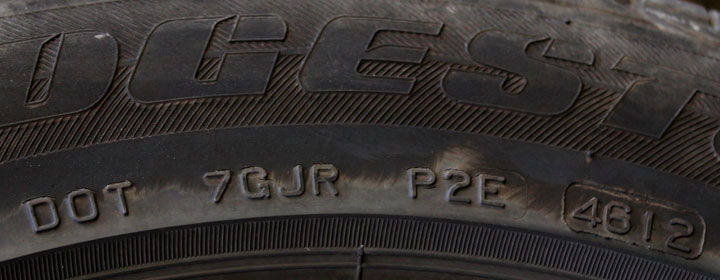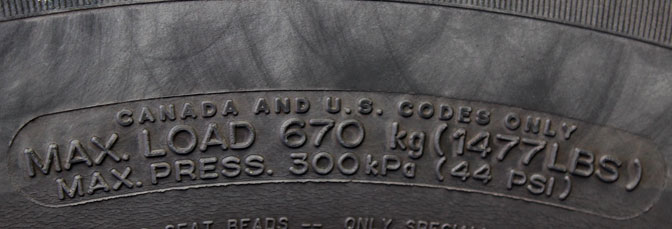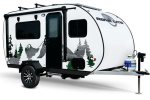Pop Up Camper Tires
Often forgotten that they even exist pop up camper tires are part of camper's successful journey....
Let’s make it clear from the beginning: pop-up campers require tires specially designed for trailers.
Under normal circumstances even if they have the same size as your car tires, they are NOT interchangeable.
And there are several reasons for that, but all of them have the common denominator – your safety!
The first major requirement for pop-up camper trailers’ tires is their ability to carry trailer’s load.
They must be rated for the GVWR of your camper. And here is the first misconception that may cost you money and frustration. The GVWR represents the combined Net Weight of the camper plus all options and extra stuff the camper is loaded with when you are taking on the road.
So what counts is:
a) extra equipment and furniture (some may be permanently installed on our demand by the dealer). These will be for example AC, generator, heater, but also awnings etc..
b) “vacation” supplies like for example camping stuff (folding chairs and tables, tents ….), kitchen “stuff”, extra coolers, linen, food, clothing, books, tools, etc…
c) Liquids (water ) and gas (propane + bottle)....
Believe me - altogether it is quickly adding up to the overall weight of the camper and its tires must be ready to carry such load (obviously your car must be also able to pull it!).
So let’s start with the short intro: How to “decipher” codes on our tires and what is their meaning.

General description you will find stamped on most tires
Source: http://en.wikipedia.org/wiki/File:Tire_code_-_en.svg
Author: Flanker
In this “jungle” of characters and seemingly “secret” codes you should find the most important information:
a) Production date
b) Type of tire
c) Load Rate and conditions (pressure)

An example of the production date - 4908 (note mini-cracks along the sidewall)
Production date (for tires made starting from 2000):
The sequence starts with DOT (Department of Transportation) and is followed by two sets of characters (mix of numbers and letters identifying the manufacturer and production plant) and it ends with four digits. And that is exactly what you need – these 4 digits represent the week and year when the tire was built.
For example number DOT xxxx xxxx 4908 means that this particular tire was manufactured during 49th week of 2008. This is quite old tire and as you can see the sidewall shows plenty of mini-cracks. Next tire shows the sequence DOT xxxx xxx 4612, in other words 46th week of 2012. No wonder, the sidewall is still in pretty god shape.

Newer Bridgestone tire manufactured during 46th week of 2012
Types of the Tires:
In US & Canada this is the ISO code consisting of letters and numbers representing the Intended Use of Tire, its size and construction (R for Radial). Intended use is represented by P for passenger car (omitted in European tires), LT for Light Truck, ST for Special Trailer and T for temporary use (for example spare tire)
ST (Special Trailer) tires - as their name points it out are designed for trailers. Their main features are:
a) higher load capabilities to accommodate typically large load variations of camper trailers;
b) higher strength of sidewalls to resist weather elements (especially UV and ozone).
You may still find somewhere so called Bias Ply trailer tires. The main construction difference compared to the radial tires is that internal cords run at an angle to the travel direction. They have stiffer sidewall (may be good for off-road driving), but on the asphalt paved roads they get hotter, have poorer handling and stability compared to radial ones. So forget about Bias Ply tires – they are legacy of the past and today may be justified only for farm applications.
The Load Rate
The Load Rate (LR) usually will be expressed as the maximum load in lbs (and/or kg) that a given tire can carry at the maximum pressure of xx PSI (yy kPa). Do not be confused- this air pressure does not represent manufacturer’s recommendation for inflation, because the right pressure depends on a vehicle where the tire is mounted! This number just says that the maximum load can be applied ONLY when the tire is inflated at maximum PSI.

An example of the tire load rating
The co-existing legacy system expresses LR in grades – B,C,D, E and so on representing “play ratings”. In old tires the number of cotton ply layers determined their strength (more layers, higher strength). So you may expect something like:
|
Load Range B |
|
And so on …………
These days tires are not made with cotton layers, so the ply rating is an “equivalent” number related to the strength and load range rather than representation of the physical construction of the tire. In other words the tire with Ply Rating of 10 may have only one or two body plies, however its strength will be equivalent to old tires with 10 body plies.
The Ply Rating is still largely used for LT and ST – types of tires.
The corresponding stamped string may for example look like follows: xxxxx R16/D where R stands for Radial, 16 is the wheel diameter (in inches) and D represents the load rating (8 Ply Rating)
The up-to-date PSI numbers for a given load rate can be verified in standards published yearly by Tire and Rim Association.
Important: You have to know your required PSI. Most guys at the service stations are familiar only with passenger cars’ tires and most likely will not know the right PSI for your pop-up camper tires!
Note:
Even in new pop-up campers you will sometimes find tires with the combined rating below campers’ GVWR. This is because manufacturer takes into account the weight of tongue (usually about 300 lbs) that is shared with the towing car. What is the deal? – Well, manufacturers (or dealers) save money, but you lose them because sooner rather than later you will have to replace these tires. The bottom line - this is a bad practice!
Tips and warnings:
a) ST tires are for trailers, not for cars! They can be used only on “pulled” axles (trailer). Under no circumstances they can be installed on drive or steering axles’ wheels of your car!
b) ST tires have the maximum speed limit of 65 mph. Excessive speed significantly increases tires temperature, inflation and wear and may cause blowout!
c) Tires on the same axle should always be matched (size, load range, inflation …). It is especially important in the case of ST tires on your pop-up camper.
d) Select the load range for your pop-up camper tires to slightly exceed GVWR of the axle the way to have some “extra” load margin (15% to 20% load margin seems to be a good practice!) It does not mean that you will be able to overload your camper. It only means that your tires will last longer, because tire’s Load Rating is specified at the maximum rated PSI inflation. But such optimum conditions do not happen in practice (air leaks, temperature, excessive speed and lack of our attention are the main culprits). Also, the trailer’s load is never distributed evenly across the axle, so one side of the axle (wheel) may be loaded more than the other one! And let me tell you – as all that can happen so it certainly will!
e) Do not expect your pop-up camper tires to achieve millage comparable to your car’s tires. Under normal circumstances the latter can make 50,000+ miles. For camper trailer tires everything above 10,000 miles is already a good number (kind of “mission accomplished” – time to replace them).
f) Under normal circumstances the main wear-factor for pop-up camper tires is Time, not the mileage! And time in this case means: exposure to sun (especially UV) and ozone. To help, you should use wheel covers and if possible, park your camper in the shade. The “life expectancy” of your camper tires is in the range of 3 to 5 years regardless of tread depth!
g) Off-road driving, under-inflation and overloading will significantly shorten the “life expectancy” of your camper tires! Under-inflation is actually the Number 1 culprit!
h) During its lifetime, your pop-up camper will mostly stay on the parking lot (or garage). That is why storage conditions are crucial for your tires. Cleaning the tires with water & soap is the first “must-to-do” action prior to the long term storage. Then if possible, you should put the camper on blocks to eliminate the prolonged weight stress on the tires and then slightly lower inflation. If this is not possible, then use a water & pavement “barrier” (for example a sheet of plywood or plastic) between the tire and the pavement. Also “from time to time” move the camper slightly to take the stress from one particular area of the tire. Protection covers for outside parking will also help.
i) Tires’ maintenance pays off! The most important maintenance steps include: frequently checking the inflation, cleaning for prolonged storage, using good tire-care products (for example 303 Protectant)…. Do not use any care-products including petrol, alcohol and silicone.
Fixing a flat on a pop-up camper
Pop up camper tires might not look too different from the regular tires that you buy for your car, but they are.
They have to carry a much bigger load, therefore they also have to be stronger and sturdier than regular car tires.
A lot of pop up users complain about flat tires and tires that damage fast, but this can be avoided if you buy the right brand with the right construction and pressure.
Pop up camper tires often have to be replaced especially when you buy a second hand one.
Many people also choose to change the tires to bigger ones so the camper can hold on better on almost any type of road. Buying tires for your pop up will be easy: most types of tires that fit a pop up camper can be found in shops such as Walmart, and there are also many places online that offer good quality pop up camper tires for great prices.
There are more types of tires available for pop up campers, differing mostly in size and model. According to the tire you would like to purchase you can choose from various places to shop from.

Ouch! Flat tire happens :-(
Visitor's Story
Before you buy the tires for your pop up camper, make sure that they are the right size and the right type. One of the most important things to consider when you purchase tires is their weight capacity. This number is usually on the sidewalls of the tires. Make sure you check the old tires and the new tires as well before you choose what type you should buy.
The most recommended tires for pop up campers are the Goodyear Marathon Radial tires. Other tires such as Carlisle are also used on pop up campers, but they are less popular and less durable according to users.
At the online store of Camping World for instance you can buy the best tires for pop ups. Here they sell high quality Goodyear tires, and for pop up campers Marathon Radial tires. You have up to 30 days to get the money back for the tires if you are not happy with them. The Marathon Radial pop up camper tires are long lasting and durable, they have a rib tread pattern, scuff guard and enhanced sidewall rubber.
They are the best choice for owners of pop up campers, because they
have the perfect weight capacity for all your stuff. They have been
developed to make towing easier and trouble free.
In the interior of these pop up campers tires there are two twin steel belts in order to increase durability of the tire. Tire Rack is another online store that has tires of all kinds, including for pop up campers. They have various models of Goodyear Marathon Radial tires such as 175/80-13 C tires, 185/80-13 C tires, 205/75-14 C tires and more.
If you are not sure what tire to purchase, it is the best to look for them in an RV store where they can tell you which model fits the best for your pop up camper.
.
About Us / Privacy Policy / Resources
5th Wheel Campers / Wheel Chock for Campers / Mini Truck Campers / How to Winterize a Camper


